KOTI Insight

RESEARCH
KOTI - Korea Transport institute
KOTI Insight Vol.1 No.2
- Date
October 31 2025
- Authors
정유진,장한별
- Page(s)
13 page(s)
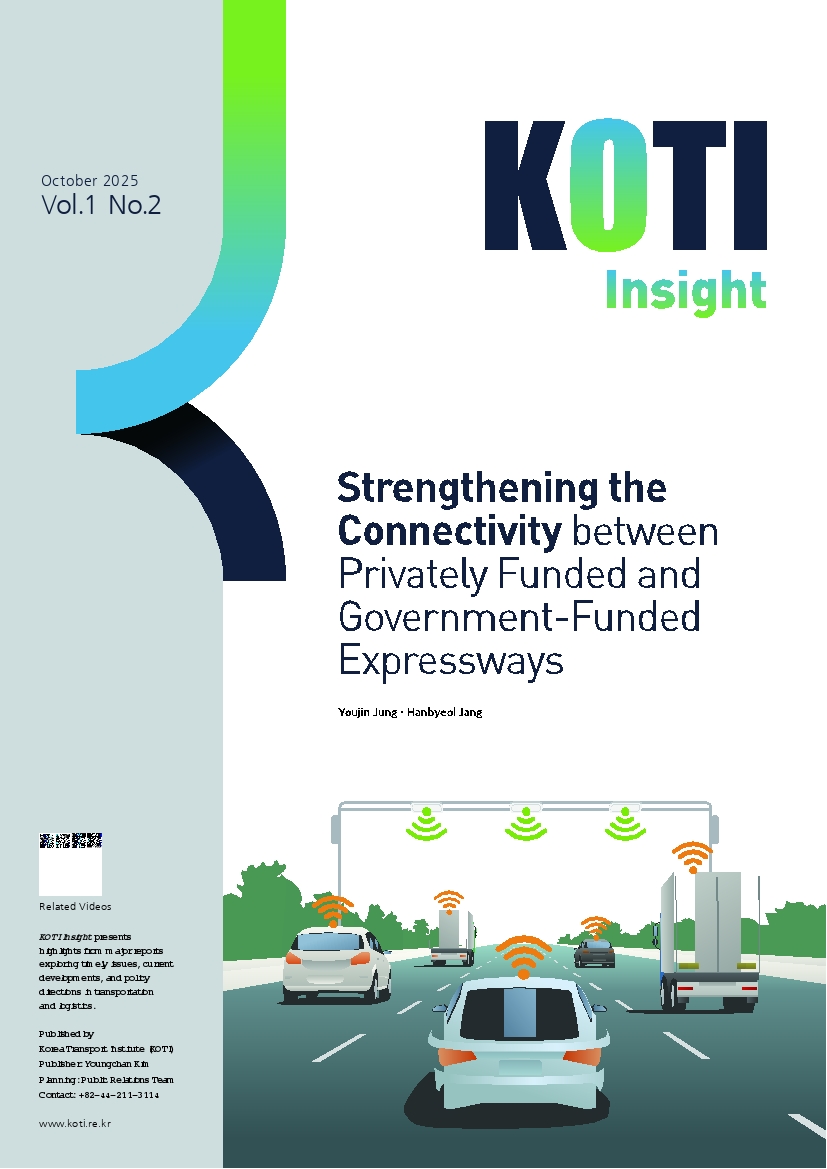
Strengthening the Connectivity between Privately Funded and Government-Funded Expressways
Youjin Jung · Hanbyeol Jang
Youjin Jung · Hanbyeol Jang
KEY SUMMARY
Korea’s expressway system operates under a dual structure of privately funded and government-funded roads, where the physical integration of the network has deepened, resulting in increasingly common interconnections between the two types. Despite the growing cross-network traffic, various operational systems―such as toll collection, billing, and delinquency management―are still operated under separate standards and frameworks, causing confusion for users and raising concerns about fairness.
In particular, the methods for additional toll charges and the refund system for overpaid tolls differ between private and government-funded expressways and even among private routes themselves, leading to ongoing user inconvenience and complaints, and underscoring the need for systematic improvement. Furthermore, with the planned introduction of smart tolling systems centered on government-funded expressways, a fundamental transformation of the existing toll collection framework is anticipated.
Privately funded expressways also need institutional and technological preparations to proactively respond to this change. In light of these evolving conditions, this study aims to develop strategies for enhancing the connectivity of toll management systems between privately funded and government-funded expressways and to propose response measures and institutional improvement directions for privately funded expressways under the smart tolling transition. The study is expected to enhance the publicness and equity of toll imposition and collection, improve user convenience, and contribute to establishing a sustainable operational foundation for privately funded roads in the long term.
01 Study Overview
Toll roads are classified into privately funded and government-funded expressways based on the entity responsible for financing and management, and refer to roads where users pay tolls to recover construction or investment costs.1) As of March 2023, expressways under the jurisdiction of the Ministry of Land, Infrastructure and Transport (MOLIT) extend a total length of 5,092.3 km, comprising 36 government-funded routes (4,238 km) and 22 privately funded routes (854.3 km).
Privately funded expressway corporations and government-funded expressways operate their toll generation, charging systems, billing and payment procedures, settlement methods, and delinquency management independently, resulting in a variety of operational issues.
"Smart tolling revolutionizes toll collection, billing, and management systems. "
It is necessary to examine user confusion and operational inefficiencies arising from the differences in management entities between government-funded and privately funded expressways, and to explore improvements and alternatives in toll management, collection and payment equity, and user convenience.
Meanwhile, the smart tolling system brings fundamental changes to toll generation, charging, billing, payment, and delinquency management processes. In the future, while road network connectivity will continue to deepen, users are expected to demand an equal level of service from both government-funded and privately funded expressways, regardless of their ownership structure. For technology-driven projects such as smart tolling, which are being planned and implemented primarily on government-funded expressways, privately funded expressways often face challenges as late adopters or encounter legal and institutional constraints.
This study aims to review institutional, regulatory, and system-related differences in toll management between privately funded and government-funded expressways, considering both interconnected and non-interconnected routes, and to develop strategies to enhance their overall connectivity.
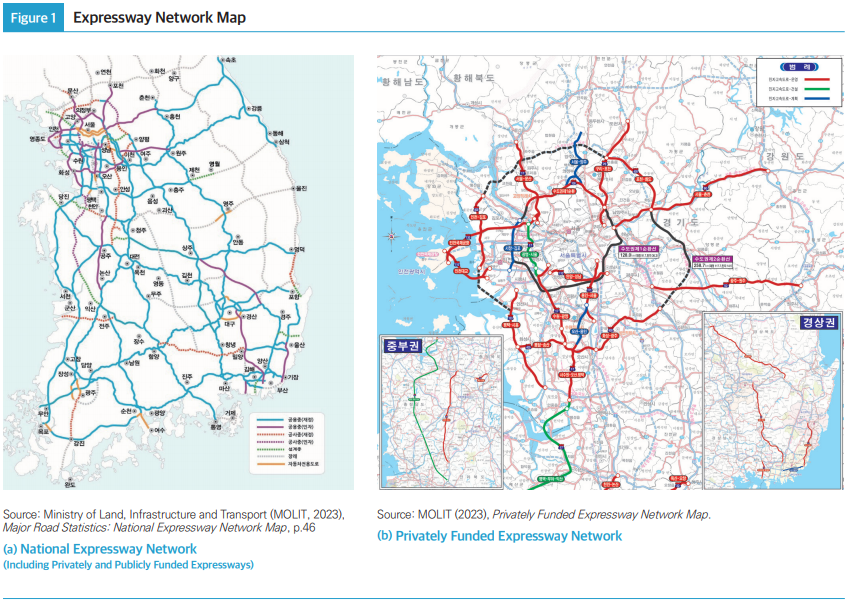
02 Research Methodology
This study first analyzed the major issues arising from differences in management entities between privately funded and government-funded expressways. The analysis focused on key issues such as overpaid toll refunds, integrated inquiry and payment systems for unpaid tolls, vehicle registration seizures for chronic high-amount delinquents, management of unpaid tolls for rental cars, and the additional toll fee system. In addition, the study examined the introduction environment of smart tolling on privately funded expressways, including implementation conditions, expected effects (direct benefits and costs), and potential impacts on toll delinquency rates. It also identified the necessary requirements and technological limitations for establishing a smart tolling process applicable to private expressway routes. Finally, based on the results of the preceding analyses, the study proposed improvement measures for toll management systems, response strategies for smart tolling implementation, and legal and institutional reforms to enhance connectivity between privately funded and government-funded expressways.

03 Key Issues Concerning Additional Toll Charges on Privately Funded and Government-Funded Expressways
The additional toll charge is a system that imposes a surcharge of ten times the original toll amount for unpaid tolls on toll roads, as stipulated in Article 20 of the Toll Road Act and Article 14 of its Enforcement Decree. However, since each privately funded expressway operator independently determines whether to impose additional tolls and applies different criteria for reduction or exemption, ongoing concerns about fairness have been raised.
Inconsistency in Additional Toll Charge and Reduction/Exemption Criteria
For government-funded expressways (managed by the Korea Expressway Corporation), additional tolls are uniformly imposed after the fourth delinquency notice, based on seven categories of unpaid toll types. In contrast, privately funded expressways autonomously decide whether to implement additional tolls by operator; among them, eight routes do not impose surcharges, while fourteen routes do.
Among the fourteen routes that impose additional tolls, seven apply them immediately upon initial nonpayment―similar to government-funded expressways―while six apply them only at the point of compulsory collection (for habitual delinquents, i.e., vehicles with 40 or more unpaid tolls within the past five years). The Hwaseong-Gwangju route imposes them only upon criminal prosecution of habitual offenders. Seven of the fourteen private routes that impose additional tolls apply the same delinquency classification criteria as the Korea Expressway Corporation.
Meanwhile, the detailed conditions for surcharge reduction also vary among operators, and some routes lack clear exemption criteria, indicating a need for standardized policy guidelines.
Discretionary Application of Surcharges and Fairness in Toll Collection
While government-funded expressways uniformly impose additional tolls, privately funded expressways determine their application at the discretion of each route operator.Some private routes impose additional tolls to improve toll collection rates and ensure stable facility maintenance, while others oppose such surcharges due to increased administrative burden and potential user complaints. Under these circumstances, it is difficult for the government to mandate the implementation of additional tolls. From the user’s perspective, when traveling across both government-funded and privately funded expressways―or between private ones―within a single trip, unpaid tolls may result in surcharges on some routes but not others, creating inconsistencies in payment fairness that warrant review. Given that toll levels on privately funded expressways are now managed at nearly the same level as those on government-funded routes, it is necessary to consider alternative surcharge policies through comprehensive consultation with all private expressway operators.
"Alternatives for imposing future additional tolls should be prepared based on opinions gathered from all privately funded expressway routes."
04 Analysis of the Introduction Environment and Impacts of Smart Tolling on Privately Funded Expressways
Concept of Smart Tolling
The smart tolling system currently being introduced on government-funded expressways is a next-generation toll collection system that allows non-stop passage, based on image recognition technology integrated with the existing HiPass infrastructure. The system determines the travel path using entry and exit image data, and users pay tolls either through an in-vehicle device or via image-based postpayment.
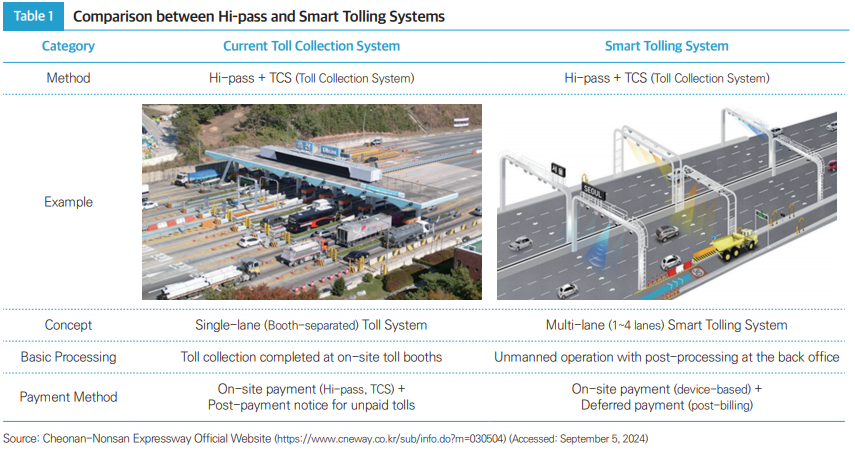
Direct Benefits and Costs of Introducing Smart Tolling on Privately funded expressways
The primary benefits of introducing smart tolling are reductions in labor costs2) and improvements in operational efficiency, with greater savings observed on routes with a higher number of toll collection system (TCS) lanes3). Labor savings were estimated based on survey responses from private expressway operators regarding personnel required per lane and the number of employees potentially reassignable to other duties. Case analysis revealed that annual labor cost savings from introducing smart tolling ranged widely―from approximately 800 million KRW to 10 billion KRW per year. Routes with relatively low labor cost savings are expected to have limited incentives for voluntarily adopting smart tolling.

In terms of cost, it is estimated that (1) upgrading existing Hi-Pass lanes requires approximately 200 million KRW, while (2) constructing a new two-lane multi-lane system costs around 1.8 billion KRW. This study assumed the installation of smart tolling on four lanes (two in each direction) directly connected to the mainline, and the cost estimates excluded expenses related to removing existing TCS lanes. As the lane configurations differ among private expressway corporations, caution should be exercised when interpreting these cost estimates.
The cost of upgrading existing Hi-Pass lanes to implement smart tolling was found to be roughly one-tenth of the cost of constructing new multi-lane systems. Therefore, it was deemed more cost-effective to first establish multi-lane Hi-Pass facilities―considering major renovation and facility replacement cycles―and gradually transition to smart tolling thereafter.
"Establishing multilane Hi-Pass systems first and then transitioning to smart tolling in stages is efficient."
05 Improvement Measures for Toll Management Systems on Privately Funded Expressways
The improvement directions for the additional toll charge system were established as: (1) enhancing fairness in the collection of unpaid tolls, (2) minimizing user confusion, and (3) establishing order in toll payment practices. Specifically, the proposed measures are categorized into: (1) applying consistent criteria across government-funded and privately funded expressways, as well as between private routes; (2) improving systems to support uniform standards; and (3) promoting public awareness campaigns to enhance understanding of toll collection policies and unpaid toll management.
It was reviewed that any adjustment to the current surcharge rate―ten times the original toll―would require amending the Enforcement Decree of the Toll Road Act.
As observed in local government cases (e.g., Gyeonggi-do and Seoul, which reduced the multiplier from tenfold to fivefold), lowering the surcharge rate could ease user burdens and encourage previously exempt routes to participate in surcharge collection―thus supporting the goal of standardization. It is also recommended to consider differentiated surcharge policies based on the reason for nonpayment (e.g., one-time vs. habitual delinquencies) to enhance user acceptability and improve toll payment compliance.
However, since amendments to the Toll Road Act Enforcement Decree would also apply to government-funded expressways, the review and public consultation process is expected to take considerable time.
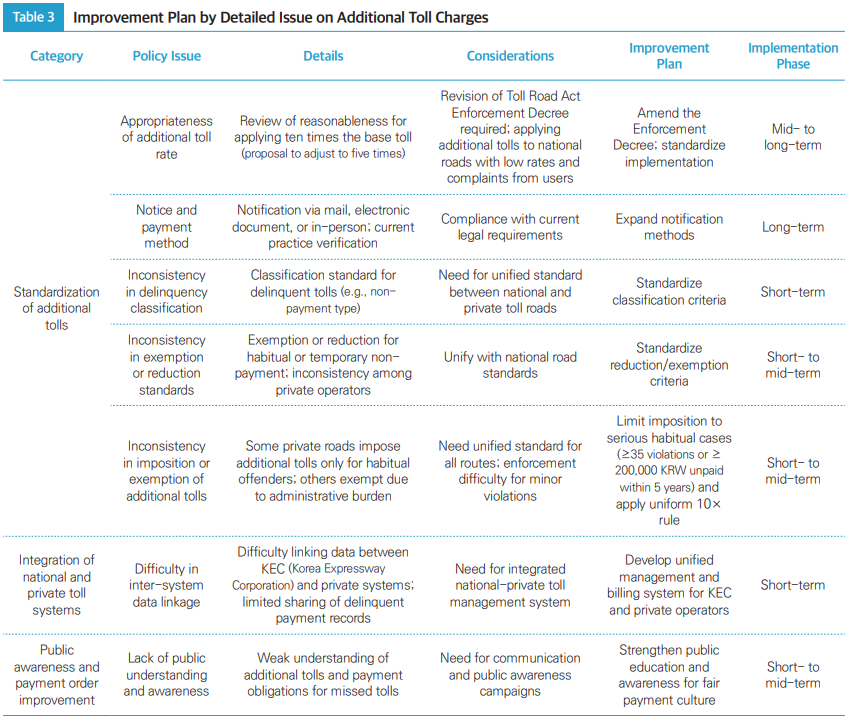
The classification of surcharge targets (types of unpaid tolls), as well as reduction and exemption criteria, can likely be standardized according to government-funded expressway practices. Inconsistencies in reduction or exemption criteria, or arbitrary application without a unified manual, can lead to user confusion and increased complaints.
Furthermore, to unify surcharge application standards, issues within the integrated tolling system between the Korea Expressway Corporation (KEC) and private sections must be resolved. Currently, in linked government-private expressway sections, there are reported cases where surcharge data from private segments are not reflected―or are arbitrarily deleted―from the KEC system. Therefore, coordination and joint system improvement with the Korea Expressway Corporation are required to resolve these linkage issues.
Several private expressway routes have expressed the need for cautious review regarding the universal application of additional tolls. Specifically, concerns include increased administrative workload for surcharge reviews and enforcement, potential public complaints on routes with high truck usage (and thus high base tolls), and limited necessity for surcharges on routes already achieving over 90% recovery of unpaid tolls.
Considering these realities, a limited unification measure could be adopted―initially imposing a tenfold surcharge only in cases of compulsory collection or criminal prosecution across all private expressway routes. Most private expressway routes already conduct compulsory collection of unpaid tolls for habitual offenders―defined as those with more than 35 unpaid cases or outstanding amounts exceeding 200,000 KRW within the past five years―through the Toll Road Management Authority and the Private Road Management Support Center.
06 Introduction and Response Strategies for Smart Tolling on Privately Funded Expressways
The response strategies of privately funded expressways to procedural changes resulting from the introduction of smart tolling are summarized in Table 4. Privately funded expressways must establish measures to enhance user convenience and improve collection efficiency regarding voluntary payment procedures for vehicles recognized via image detection (i.e., non-Hi-Pass users). Since the current billing and payment methods for privately funded expressways are limited within existing legal boundaries, continuous institutional and technological efforts are required to expand these capabilities.
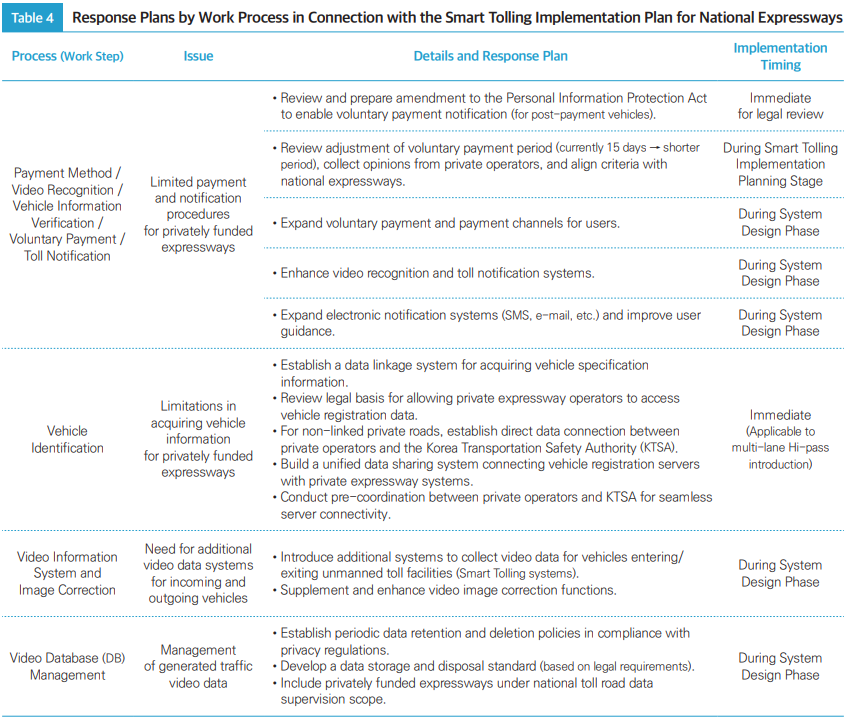
When establishing new toll management standards―such as the duration of voluntary payment periods―it is essential to ensure consistency between privately funded and government-funded expressways, thereby minimizing user confusion. To achieve this, systematic procedures for consultation, review, and information sharing among the Toll Road Management Authority, Korea Expressway Corporation, and private expressway operators must be established.
Meanwhile, since the introduction of smart tolling could potentially lead to an increase in unpaid tolls, corresponding management measures are necessary. In particular, reducing the cost of unpaid toll notifications is crucial; therefore, across all sections―including those linked with government-funded routes―there is a need to diversify notification types and expand payment options.
Specifically, for independent private expressway routes (non-linked), it is necessary to establish a system that enables quick and efficient access to vehicle specification data from the Korea Transportation Safety Authority, based on license plate information obtained through image recognition. To this end, a direct server linkage system between the Korea Transportation Safety Authority and private operators should be established, accompanied by administrative consultations and technical coordination among the Toll Road Management Authority, private operators, and the Authority.
"During the implementation of smart tolling, participation in the public-private consultation body is essential for gathering opinions and improving information-sharing procedures."
Given the high costs associated with implementing smart tolling, differences in financial capacity across private expressway routes must be taken into account. Accordingly, it is necessary to establish a phased implementation strategy that reflects each facility’s replacement and system renewal cycles to prevent redundant investments. In particular, for routes where multi-lane Hi-Pass can be introduced, it is advisable to first adopt this cost-effective alternative and then gradually transition to smart tolling. Based on this, each operator should develop a route-specific implementation schedule and establish a corresponding management system.
Meanwhile, independent private expressway routes have so far been excluded from ongoing discussions on smart tolling deployment projects. Due to differences in business conditions and road characteristics, these routes inevitably must decide on adoption independently. However, to ensure that both private and government-funded expressways provide an equally high standard of service, independent routes should participate in future joint consultation bodies between the two sectors to strengthen dialogue and information-sharing during the smart tolling implementation process.
Legal and Institutional Improvement Measures
Since smart tolling applies a post-payment system based on image recognition, ensuring prompt toll collection within the voluntary payment period becomes the most critical task. Under the current legal framework, the system waits for users to voluntarily pay tolls; once the voluntary payment period has expired, unpaid tolls are notified after vehicle registration verification. Therefore, institutional mechanisms are required to enable timely toll notification and encourage user payment within the voluntary payment period to increase collection rates. To achieve this, amendments are needed to the Personal Information Protection Act to clarify the legal basis for using personal data in voluntary toll notifications, as well as to Article 21-3(1)(2) of the Toll Road Act. Accordingly, this study proposes the following legislative amendments to strengthen the legal foundation for voluntary toll payment notification.

07 Conclusion and Policy Recommendations
This study aimed to examine the confusion experienced by users and the operational inefficiencies arising from differences in management entities between governmentfundedand privately funded expressways. It also sought to identify potential challenges and propose corresponding solutions for privately funded expressways in anticipation of the forthcoming introduction of smart tolling―a new toll imposition and collection system.
This study reviewed and proposed alternative measures for improving toll management and introducing smart tolling on privately funded expressways, in connection with government-funded expressway systems. During the review of each alternative, system-related issues were identified, and the specific characteristics and operational conditions of each private expressway operator were considered to enhance the practical applicability of the policy alternatives. In particular, the proposed improvement measures established clear legal foundations to facilitate implementation and included draft amendments to the Toll Road Act.
The proposed improvements to toll management systems―including the additional toll and refund mechanisms―are expected to contribute to more rational toll administration on privately funded expressways, enhance user convenience, and promote fairness in toll payments. Furthermore, as a preliminary study on the introduction of smart tolling to privately funded expressways, the proposed measures are anticipated to serve as a foundation for establishing future policy directions concerning the management of both interconnected and independent private routes, which are expected to expand in number.
"Improvements to the toll management system are expected to contribute to rational toll management on privately funded expressways, enhance user convenience, and improve payment equity"
1) Articles 16 and 17 of the Toll Road Act
2) Korea Expressway Corporation (2021), Study on the Implementation Effects and Policy Directions for the Next-Generation Tolling System, p.77.
3) A manned lane equipped with a Toll Collection System (TCS)
[ References ]
Ministry of Land, Infrastructure and Transport (MOLIT). (2023). Major Road Statistics: National Expressway Network Map, p.46.
Ministry of Land, Infrastructure and Transport (MOLIT). (2023). Privately Funded Expressway Network Map.
Cheonan-Nonsan Expressway Website. (n.d.). Retrieved from https://www.cneway.co.kr/sub/info.do?m=030504 (Accessed on September 5, 2024).
Korea Transport Institute (KOTI). (2024). Survey on the Current Status of Additional Toll Charges. Internal Data.
Korea Expressway Corporation (KEC). (2021). Study on the Implementation Effects and Policy Directions for the Next-Generation Tolling System, pp.169-183.
Korea Expressway Corporation (KEC). (2023). National Policy Project: Smart Tolling Introduction Plan, pp.1-4.
Statistics Korea. (2024). Status of Toll Roads (e-나라지표). Retrieved from https://www.index.go.kr/unity/potal/main/EachDtlPageDetail.do?idx_cd=1210 (Accessed on May 2, 2024).
National Law Information Center. (2024). Toll Road Act. Retrieved from https://www.law.go.kr/LSW/main.html (Accessed on September 4, 2024).
01 Study Overview
02 Research Methodology
03 Key Issues Concerning Additional Toll Charges on Privately Funded and Government-Funded Expressways
04 Analysis of the Introduction Environment and Impacts of Smart Tolling on Privately Funded Expressways
05 Improvement Measures for Toll Management Systems on Privately Funded Expressways
06 Introduction and Response Strategies for Smart Tolling on Privately Funded Expressways
07 Conclusion and Policy Recommendations
02 Research Methodology
03 Key Issues Concerning Additional Toll Charges on Privately Funded and Government-Funded Expressways
04 Analysis of the Introduction Environment and Impacts of Smart Tolling on Privately Funded Expressways
05 Improvement Measures for Toll Management Systems on Privately Funded Expressways
06 Introduction and Response Strategies for Smart Tolling on Privately Funded Expressways
07 Conclusion and Policy Recommendations